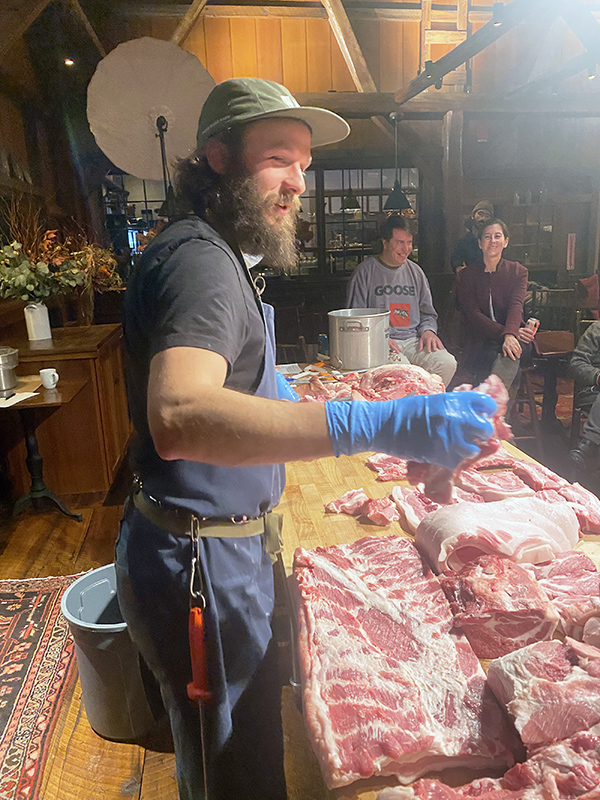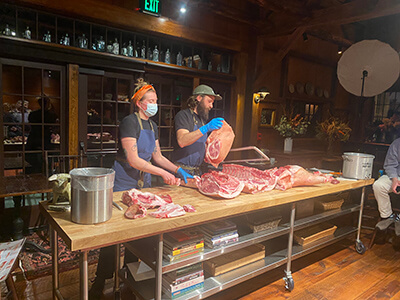The craft of cutting meat
Philo Ridge Farm offers butchering workshops
My 4-year-old grandson has no concept of a musical earworm and insists that he never gets songs stuck in his head.
However, he says, “Sometimes I get bacon stuck in my head because I love it so much.”
Although a butchering workshop at the end of January at Philo Ridge Farm is clearly for people much older than him, maybe someday, if my grandson’s still obsessed with bacon, the seminar on how to cut up a hog might be something he’ll be interested in.
This may be the first of what could lead to other workshops at the farm. In fact, there is another workshop called Volume I: The Whole Hog this Tuesday, Feb. 28, 6-8 p.m. For more information visit the Philo Ridge website or call 802-539-2147.

Mike Kirk gives a hog butchering demonstration at Philo Ridge Farm.
The folks at Philo Ridge Farm are gauging the interest and contemplating the viability of continuing the series with workshops on butchering beef, lamb, mutton, possibly even chicken. If the attendance and enthusiasm for the initial workshop is any indication, the demand may be so great that eventually they will get to the proper way to butcher tofu.
Running throughout the presentation by Philo Ridge Farm butchers Mike Kirk and Hannah Clark was the theme of how important it is to utilize every part of the pig that they can.
“We strive to use every piece of the animal. I’m not going to lie — that is challenging,” Kirk said. “There’s a lot that people just don’t know.”
People don’t know about many cuts of pork that are actually delicious, so it can be difficult to market some parts of a pig. Kirk said they work to teach people about cuts that are their favorites but that most people are unaware of.
“It’s a little-known fact that some of the most tender muscles originate in the neck of the animal,” he said at one point in the demonstration.
They started off the presentation by showing the tools of their trade. It was a variety and quality of knives that would make Freddy Krueger envious.
Let’s be clear, the workshop began with the hog already killed, offsite and returned to the farm in two halves, so to be technical, it wasn’t actually the whole hog. But every part was there, including bacon.
Initially, the hog is cut into its primal parts — head, shoulder, loin, sirloin and leg. The primal cuts were then cut into subprimal cuts. So, for instance, the shoulder can be cut into a Boston butt, a picnic shoulder, hock and foot.
Clark said the hogs at Philo Ridge Farm are not technically organic because they are fed compost scraps, but the grain they are fed is certified organic. And they are pasture raised.
The hogs on the farm are heritage breeds, which is somewhat like heirloom vegetables. They are similar to the pigs our forefathers raised. They haven’t been repeatedly bred to emphasize parts of the hog that are popular or commercial.

Hannah Clark and Mike Kirk work through the process of cutting a hog down into its primal parts.
“They haven’t been modified for the commercial market,” said Peter Swift, co-owner of Philo Ridge with his wife Diana McCargo. “The commercial pigs are much longer.”
One reason the farm likes heritage breeds is because they tend to have a better flavor. But a drawback for large-scale hog farmers is that heritage breeds don’t grow as fast as commercial breeds.
When the weather is warm enough the pigs are rotated to different areas of Philo Ridge Farm for grazing, sometimes daily but at least weekly.
And the pigs are put to work, helping to renovate fields. They may be placed in fields that are scrubby on the edge. As the pigs go in and out of the woods, their rooting and foraging turn the soil, getting rid of the brush. Then the farm team can reseed those areas to eventually be grazed by cattle or sheep.
Unlike a traditional butchery, the butchers at Philo Ridge can respond to what their kitchen and their market needs, while making sure they are utilizing every part that they can, Kirk said.
One of the commonly known ways of determining better tasting pork or beef is to look for marbling, which is fine white flecks of fat that appear within the muscles of red meat. An old saying in the industry is fat is flavor.
Kirk believes their pork has more marbling than commercial breeds. Part of the reason for that is: “They’re allowed to be pigs. They’re allowed to move and to express themselves as pigs,” he said.
As Kirk and Clark instructed and demonstrated their butchering craft, George Stinson, director of hospitality, demonstrated his hospitality craft, periodically moving among the participants with delectable samples from the kitchen of whatever cut was being harvested.
Please don’t tell my grandson, but as the workshop neared its close, Stinson showed up with a plate full of one of the farm’s newest products smoked and cured in-house — maple bacon.
The evening ended with a meal from the farm’s kitchen, featuring Philo Ridge Farm products.
Although this reporter hasn’t eaten pork in at least 20 years, I did fall off the wagon.
As a friend is fond of saying, “Bacon has been the downfall of many a vegetarian.”
